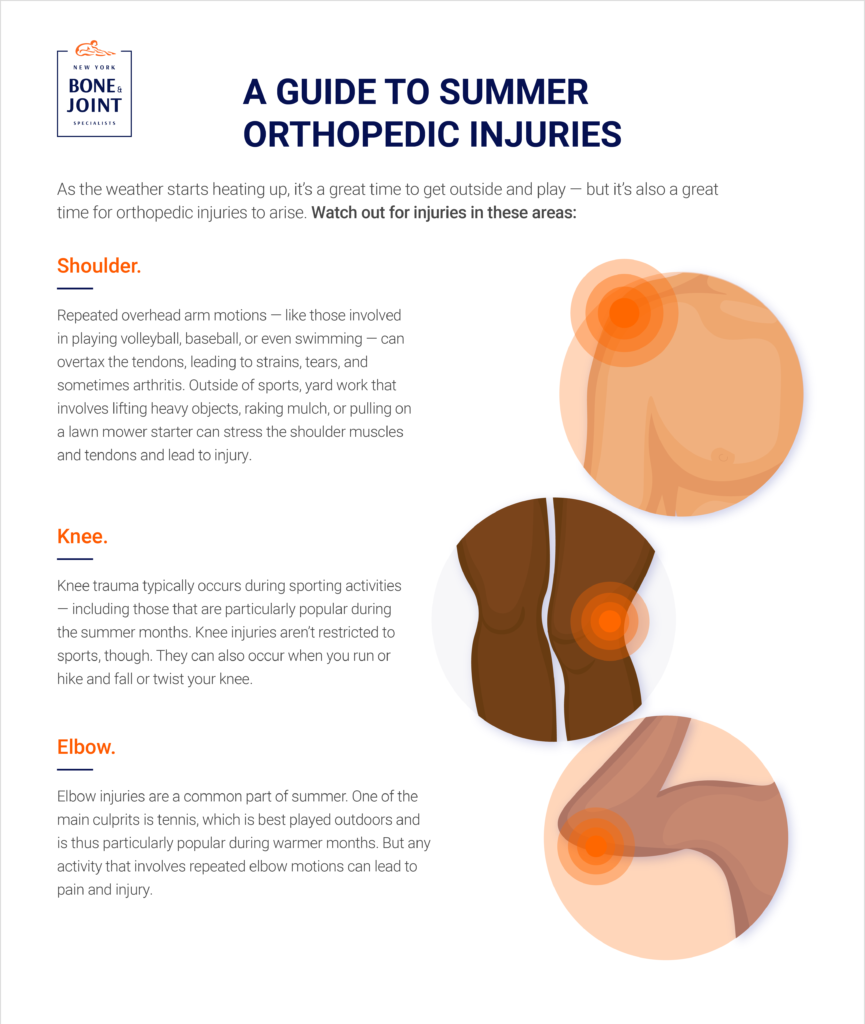When the weather starts heating up, it’s a great time to get outside and play — but it’s also a great time for orthopedic injuries to arise.
One of the best parts of warmer weather is being able to enjoy outdoor activities once again. Whether it’s participating in sports or simply clearing the garden, summer is the perfect time to get out and enjoy the sunshine and fresh air after a long winter. Unfortunately, although you may be ready to dive into fun, outdoor leisure-time pursuits, your body — especially your muscles and tendons — may not be.
Jumping straight into summertime activities after hibernating can injure muscles that are rigid from months of inactivity. But you don’t have to hold off on doing what you love. With preparation, you can avoid the most common summer orthopedic injuries so you can get out and enjoy the sunshine!
Common Summertime Orthopedic Injuries
Like most orthopedic injuries, the majority of summertime injuries occur due to repetitive motions, or, in some cases, a trauma to the joint. Here are the parts of the body most likely to experience injury from warm-weather activities.
Shoulder. Your shoulder joint allows you to rotate your arm in different directions as well as lift your arm above your head. These motions are possible because of a network of tendons and muscles that secure the upper arm bone to the socket of the shoulder known as the rotator cuff. However, repeated overhead arm motions — like those involved in playing volleyball, baseball, or even swimming — can overtax the tendons, leading to strains, tears, and sometimes arthritis. Outside of sports, yard work that involves lifting heavy objects, raking mulch, or pulling on a lawn mower starter can stress the shoulder muscles and tendons and lead to injury.
Knee. Knee trauma typically occurs during sporting activities — including those that are particularly popular during the summer months. When playing football or soccer, your knee may be forced out of its normal alignment by a hard hit or an awkward landing, causing a tear of the anterior cruciate ligament (ACL), which stabilizes the joint. The medial collateral ligament (MCL), which runs along the inside of the knee and connects the shinbone, or tibia, to the femur, or thighbone, is also vulnerable to injury. Knee injuries aren’t restricted to sports, though. They can also occur when you run or hike and fall or twist your knee.
Elbow. Elbow injuries are a common part of summer. One of the main culprits is tennis, which is best played outdoors and is thus particularly popular during warmer months. But the high-intensity exercise can sometimes lead to tennis elbow, or lateral epicondylitis. Swinging a racket repeatedly can inflame the tendons of the elbow and forearm, causing pain radiating down from the forearm to the wrists. And it’s not just your elbow that’s vulnerable to injury from repetitive motions like playing tennis, pulling weeds, catching a ball, or hammering nails. These activities can result in strains in the hand and wrist ligaments or possibly even a dislocated finger if you aren’t careful.

Treating and Preventing Summertime Orthopedic Injuries
If you believe you suffered an injury, the best course of treatment is the RICE method: Rest, Ice, Compression, and Elevation. Over-the-counter pain reducers can also help relieve the discomfort. If the pain fails to subside, consult with an orthopedist to determine the cause and develop a therapeutic plan.
Of course, prevention is always better than treatment. With these four tips you can safely perform your favorite summer activities:
Warm Up. Just because it’s hot doesn’t mean your muscles are warm. Before any activity, take 15 minutes to stretch and warm up your muscles and prepare for the exercise. When you stretch, blood rushes to your muscles, which allows the muscles to absorb the nutrients needed for stronger tissues. It also helps unlock stiff muscles. That’s important given that stiff, inflexible muscles often lead to preventable injuries.
Exercise All Year. Suddenly dashing into playing a game or doing work around the house can be a shock to your muscles and joints. By working out throughout the year — even if you stick to low-impact exercises — you’re better prepared to handle more rigorous activities in the summer months. As with any activity, if you feel tired or achy, take a break and rest.
Use Proper Technique. Whether throwing a baseball, swinging a tennis racket, or raking the yard, following proper technique is key to avoiding injury. If you’re unsure of the proper stance or technique, work with a coach or trainer. Good posture also helps prevent injury no matter the activity.
Eat Right. What you consume sets the stage for strong bones and healthy muscles. For example, if you lack calcium in your diet, your body will sap your bones of the nutrient, leading to weaker bones. Although you may avoid fats, a healthy amount of dietary fats in your meals (avocados, nuts, and extra virgin olive oil) boosts your energy level and increases hormone production and nutrient absorption — all of which are needed to protect muscles and joints from injury. Protein-rich foods like chicken, eggs, and tuna are also good energy boosters. And don’t forget to wash your meals down with plenty of water for good hydration in the heat!
Get Ready for an Injury-Free Summer
If you’re worried about injuring yourself this summer — or at any time — with one of your favorite activities, it’s a good idea to see an orthopedist or physical therapist who can work with you to design a game plan that keeps your muscles, bones, and joints healthy and safe.
At New York Bone & Joint Specialists, we can not only help you prepare for a safe summer, we also offer treatments for a variety of orthopedic conditions and injuries if anything does happen. Using both surgical and non-surgical methods, we will help you overcome pain so you can enjoy everything summer has to offer. Contact us today for a consultation.




